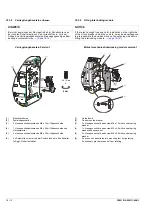
3ZW1012-0WL11-0AB1
18 – 1
7
18
Mutual mechanical circuit breaker
interlocking
In the standard design there are various versions for the mutual
interlocking system available, comprising a maximum of three cir-
cuit breakers.
18.1
Mutual mechanical interlocking module
(1)
Output 1
(2)
Version 1: Holes for plastite screw with toothed lock washer for
the configuration of the mutual mechanical circuit breaker
interlocking
Version 2: Holes with press nut for cheese-head M6 with washer
for the configuration of the mutual mechanical circuit breaker
interlocking
(3)
Non-interchangeable brackets
(4)
Input 1
(5)
Input 2
(6)
Output 2
(1)
(2)
(3)
(4)
(5)
(6)
Version 2
18
Gegenseitige mechanische Verriegelung
Ermöglicht in der Standardausführung verschiedene Varianten der
gegenseitigen Verriegelung von maximal drei Leistungsschaltern.
18.1
Verriegelungsbaustein
(1)
Ausgang 1
(2)
Version 1: Bohrung für Plastite Schraube mit Zahnscheibe für
die Konfigurierung der gegenseitigen Verriegelung
Version 2: Bohrung mit Setzmutter für Zylinderkopfschraube
M6 mit Scheibe für die Konfigurierung der gegenseitigen Verrie-
gelung
(3)
Indexbügel
(4)
Eingang 1
(5)
Eingang 2
(6)
Ausgang 2
HINWEIS
NOTICE
Für die Funktion der Verriegelung sind in der Schaltanlage Mindest-
voraussetzungen zu schaffen:
1
Bowdenzüge sind möglichst gerade, wenig gekrümmt zu
verlegen.
2
Biegeradien des Bowdenzuges müssen > 500 mm ausge-
führt sein.
3
Im Bowdenzugverlauf darf die Summe aller Krümmungs-
winkel 540° nicht überschreiten.
4
Bei vertikaler Anordnung zu verriegelnder Leistungsschalter
sollen die Verriegelungsmechaniken fluchten.
5
Zu verriegelnde Leistungsschalter müssen so angeordnet
sein, dass 2 m, 3 m oder 4,5 m lange Bowdenzüge unter
Einhaltung der in den Punkten 1. - 4. genannten Bedingun-
gen optimal verlegt werden können.
6
Die Bowdenzugverlegung muss vor der Justage der Verrie-
gelung fixiert werden (Kabelbinder o.ä.)
7
Durch die Wahl der Schaltanlagenfachbreite muss die
Justagefreiheit für die Verriegelung gewährleistet sein.
8
Öffnungen und Durchbrüche in Anlagenelementen sind so
zu gestalten, dass durchgeführte Bowdenzüge im Verlauf
nicht richtungsorientiert oder behindert werden.
For a proper function of the interlocking device, the following mini-
mum prerequisites have to be met in the switchgear:
1
Bowden cables are to laid out as straight and as unbowed
as possible.
2
Bending radii of the bowden wires must exceed > 500 mm.
3
The total curving of the bowden wire must not exceed
540 degrees.
4
When stacking interlocked circuit breakers vertically, the
interlocking devices shall be in line with each other.
5
Circuit Breakers intended to be interlocked must be posi-
tioned, so that bowden wires of 2 m, 3 m or 4.5 m length
can be laid out optimally, while complying with the condi-
tions of paragraphs 1. to 4.
6
Before adjusting the interlocking device, the laying of
bowden wires must be fixed, e.g. using cable ties.
7
The width of the switchgear section must be selected as
wide as necessary to ensure space for an adjustment of the
interlocking device.
8
Openings have to be created in the switchgear components,
so that bowden wires are not forced in their orientation or
direction and that they are not hindered in their run.
0428
(1)
(2)
(3)
(4)
(5)
(6)
Version 1
Содержание 3ZW1012-0WL11-0AB1
Страница 15: ...3ZW1012 0WL11 0AB1 0 XV ...
Страница 87: ...3ZW1012 0WL11 0AB1 8 15 S Auslösung I Auslösung S tripping I tripping ...
Страница 88: ...8 16 3ZW1012 0WL11 0AB1 Erdschlussauslösung Ground fault tripping ...
Страница 251: ...3ZW1012 0WL11 0AB1 14 15 Arranging lock assembly Installing Schlossbaugruppe vormontieren Einbau 0767 1 2 3 4 6 5 ...
Страница 359: ...3ZW1012 0WL11 0AB1 27 5 ...
Страница 360: ...27 6 3ZW1012 0WL11 0AB1 ...
Страница 366: ......
Страница 367: ......
















































